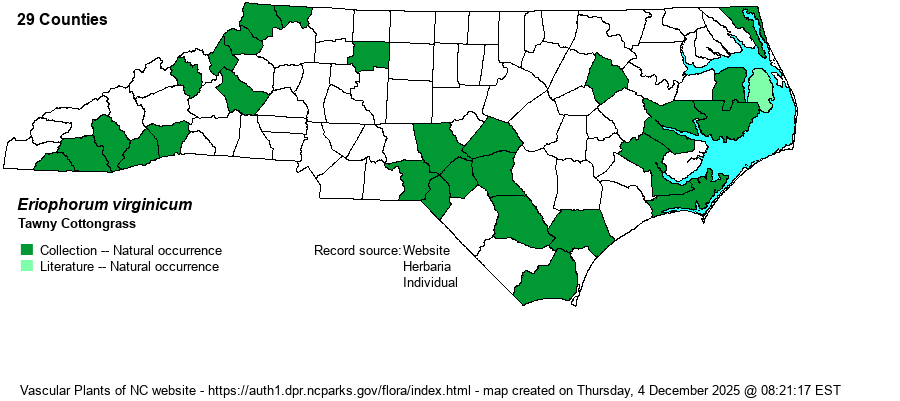| Author | L. | |
| Distribution | Mostly Mountains, Sandhills, and the outer Coastal Plain. Nearly absent from the Piedmont, and it clearly has a bimodal range in NC.
Lab. to Ont. and MN, south to SC, GA, and IL. | |
| Abundance | Uncommon in the Mountains, Sandhills, and lower Coastal Plain. Very rare in the Piedmont and northern half of the Coastal Plain. Though this is considered as a Watch List species by the NCNHP, there are specimen records for at least 28 counties, and with a rank combination of G5S3, there seems little need for it being on a Watch List now. | |
| Habitat | Southern Appalachian bogs, peaty streamhead ecotones, beaver ponds, wet pine savannas, peaty pocosins. Typically associated with pitcher-plants and sphagnum moss, often in unstable and very spongy ground. |
| Phenology | Flowering and fruiting June-September. | |
| Identification | This is an unmistakable plant with its large cotton-like tuft atop each stem, ranging from whitish to tawny, and about 2 inches across and 1 inch high -- impossible to miss. The tuft actually is composed of bristles that grow from the bases of seeds. Of course, if this large cottony tuft is not visible, the species can be easily overlooked. A bog or seepage area with a stand of this plant in full "regalia" is a spectacular sight, with each "cotton ball" looking at a distance like a dense flower cluster of a forb species and not a sedge. | |
| Taxonomic Comments | This is the only cottongrass that has been verified for NC.
| |
| Other Common Name(s) | Tawny Cottonsedge, Cottongrass. Of course, Tawny Cottonsedge is a more appropriate name, as this species is not a grass. | |
| State Rank | S3 | |
| Global Rank | G5 | |
| State Status | W1 | |
| US Status | | |
| USACE-agcp | OBL link |
| USACE-emp | OBL link |

